Do you have a question about the Siemens EQ300 TF301E09 and is the answer not in the manual?
Basic guidelines for safe handling, keeping the manual, and avoiding damaged appliances.
Defines the correct application and environment for the appliance: hot drinks in domestic settings up to 2000m.
Specifies age limits (8+) and capability requirements for users, and child safety measures.
Details specific hazards like suffocation from packaging and general safety advice.
Details hazards related to incorrect installation, damaged cords, and moisture ingress.
Warns about overheating, using in cupboards, and improper use of extension cords or adapters.
Alerts users to hot appliance parts and advises allowing them to cool before touching.
Warns about hot drinks and steam contacting skin.
Covers general injury risks like trapped fingers and reaching into the grinder.
Advises people with electronic implants to maintain distance due to permanent magnets.
Addresses health risks from appliance soiling and emphasizes following cleaning instructions.
Advises on environmentally sound disposal of packaging materials by sorting components.
Provides advice on reducing appliance power consumption, such as setting auto-off and descaling regularly.
Lists items included in the package and checks for any damage in transit.
Instructions for physically setting up the appliance on a level surface and connecting it to an earthed socket.
Overview of the appliance's main parts and features, with a note on model variations.
Explains the functions and indicators on the control panel for configuring operations and status.
Instructions for initial cleaning, removing protective foils, and preparing the appliance before first use.
Notes on factory settings, operation, steam escape, automatic switch-off, and signal tones.
Information on using a water filter to minimize limescale and impurities, including insertion and replacement.
Steps to remove the water filter and related settings, and tips for maintenance and flavour.
How to power the appliance on and off, including automatic rinsing cycles.
General guidance on preparing drinks, with a warning about hot liquids and steam.
Steps for brewing coffee from beans, including setting coffee strength.
Instructions for making milk-based drinks like cappuccino and latte macchiato.
Specific instructions for frothing milk only, with tips on milk quality.
How to adjust coffee strength and filling level for customized drinks.
How to customize the duration for frothing milk for different drinks.
Guide to setting the fineness of the coffee bean grind using the rotary selector.
How to configure the automatic switch-off timer duration.
How to enable or disable the button sound feedback.
How to set water hardness for accurate descaling reminders.
Instructions to restore the appliance's default configurations, erasing user settings.
Identifies parts suitable for cleaning in a dishwasher and those that are not.
Recommends suitable cleaning agents and warns against unsuitable ones that may damage surfaces.
Detailed steps for cleaning the appliance's exterior, high-gloss surfaces, and control panel.
Instructions for daily cleaning and emptying of the drip tray and coffee dregs container.
Steps for cleaning the milk frother after each use to remove residues and ensure proper function.
Guidance on regularly removing and cleaning the brewing unit, following illustrated instructions.
Information about running maintenance programs like Calc'nClean for descaling and cleaning.
Steps to take when the appliance is unresponsive, including power cycling.
Troubleshooting for issues where the appliance dispenses only water, not coffee.
Addressing inconsistent drink quality, such as variations in coffee or milk froth.
Diagnosing and resolving issues with slow or no coffee dispensing to a trickle.
Troubleshooting when the selected drink volume is not reached.
Addressing issues with milk or milk-based drinks being too hot or too cold.
Troubleshooting thin milk froth and loud suction noise during milk frothing.
Tips for improving coffee crema and addressing issues with acidity or bitterness.
Addressing burnt coffee taste, often related to grinding level or coffee variety.
General troubleshooting for failures in dispensing drinks, including milk froth.
Addressing water leaks or dripping water on the inner floor of the appliance.
Steps for when the brewing unit is jammed and cannot be removed.
Troubleshooting the grinder not operating, often due to the appliance being too hot.
Resolving various LED indicator problems, such as flashing lights or incorrect status displays.
Steps for when the appliance is unresponsive or in demo mode.
Instructions for preparing the appliance for transport or storage to protect it from frost.
Guidance on environmentally friendly disposal of the appliance according to WEEE directive.
How to find and note the appliance's product (E-Nr.) and production (FD) numbers for service.
Basic guidelines for safe handling, keeping the manual, and avoiding damaged appliances.
Defines the correct application and environment for the appliance: hot drinks in domestic settings up to 2000m.
Specifies age limits (8+) and capability requirements for users, and child safety measures.
Details specific hazards like suffocation from packaging and general safety advice.
Details hazards related to incorrect installation, damaged cords, and moisture ingress.
Warns about overheating, using in cupboards, and improper use of extension cords or adapters.
Alerts users to hot appliance parts and advises allowing them to cool before touching.
Warns about hot drinks and steam contacting skin.
Covers general injury risks like trapped fingers and reaching into the grinder.
Advises people with electronic implants to maintain distance due to permanent magnets.
Addresses health risks from appliance soiling and emphasizes following cleaning instructions.
Advises on environmentally sound disposal of packaging materials by sorting components.
Provides advice on reducing appliance power consumption, such as setting auto-off and descaling regularly.
Lists items included in the package and checks for any damage in transit.
Instructions for physically setting up the appliance on a level surface and connecting it to an earthed socket.
Overview of the appliance's main parts and features, with a note on model variations.
Explains the functions and indicators on the control panel for configuring operations and status.
Instructions for initial cleaning, removing protective foils, and preparing the appliance before first use.
Notes on factory settings, operation, steam escape, automatic switch-off, and signal tones.
Information on using a water filter to minimize limescale and impurities, including insertion and replacement.
Steps to remove the water filter and related settings, and tips for maintenance and flavour.
How to power the appliance on and off, including automatic rinsing cycles.
General guidance on preparing drinks, with a warning about hot liquids and steam.
Steps for brewing coffee from beans, including setting coffee strength.
Instructions for making milk-based drinks like cappuccino and latte macchiato.
Specific instructions for frothing milk only, with tips on milk quality.
How to adjust coffee strength and filling level for customized drinks.
How to customize the duration for frothing milk for different drinks.
Guide to setting the fineness of the coffee bean grind using the rotary selector.
How to configure the automatic switch-off timer duration.
How to enable or disable the button sound feedback.
How to set water hardness for accurate descaling reminders.
Instructions to restore the appliance's default configurations, erasing user settings.
Identifies parts suitable for cleaning in a dishwasher and those that are not.
Recommends suitable cleaning agents and warns against unsuitable ones that may damage surfaces.
Detailed steps for cleaning the appliance's exterior, high-gloss surfaces, and control panel.
Instructions for daily cleaning and emptying of the drip tray and coffee dregs container.
Steps for cleaning the milk frother after each use to remove residues and ensure proper function.
Guidance on regularly removing and cleaning the brewing unit, following illustrated instructions.
Information about running maintenance programs like Calc'nClean for descaling and cleaning.
Steps to take when the appliance is unresponsive, including power cycling.
Troubleshooting for issues where the appliance dispenses only water, not coffee.
Addressing inconsistent drink quality, such as variations in coffee or milk froth.
Diagnosing and resolving issues with slow or no coffee dispensing to a trickle.
Troubleshooting when the selected drink volume is not reached.
Addressing issues with milk or milk-based drinks being too hot or too cold.
Troubleshooting thin milk froth and loud suction noise during milk frothing.
Tips for improving coffee crema and addressing issues with acidity or bitterness.
Addressing burnt coffee taste, often related to grinding level or coffee variety.
General troubleshooting for failures in dispensing drinks, including milk froth.
Addressing water leaks or dripping water on the inner floor of the appliance.
Steps for when the brewing unit is jammed and cannot be removed.
Troubleshooting the grinder not operating, often due to the appliance being too hot.
Resolving various LED indicator problems, such as flashing lights or incorrect status displays.
Steps for when the appliance is unresponsive or in demo mode.
Instructions for preparing the appliance for transport or storage to protect it from frost.
Guidance on environmentally friendly disposal of the appliance according to WEEE directive.
How to find and note the appliance's product (E-Nr.) and production (FD) numbers for service.
| Coffee Bean Container Capacity | 250 g |
|---|---|
| Water Tank Capacity | 1.4 L |
| Pump Pressure | 15 bar |
| Milk Frother | Yes |
| Color | Black |
| Power Consumption | 1300 W |
| Voltage | 220-240 V |
| Frequency | 50/60 Hz |
| Programmable | Yes |
| Type | Automatic Coffee Machine |
| Grinder | Yes |
| Display | Yes, LED |
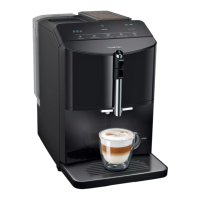
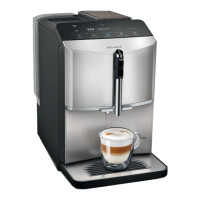
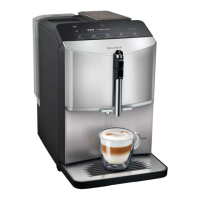
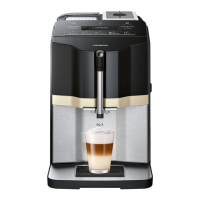
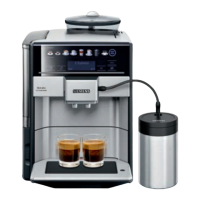
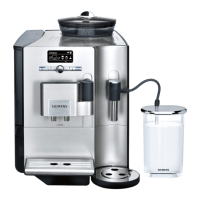
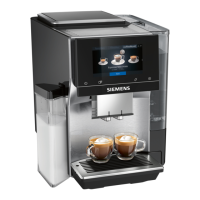
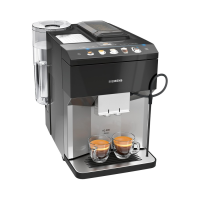
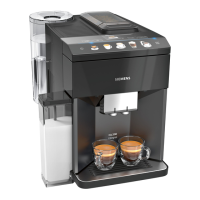
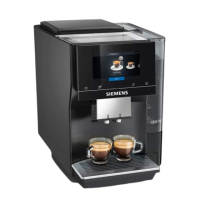
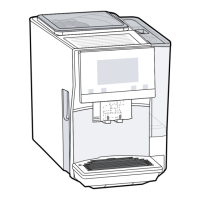
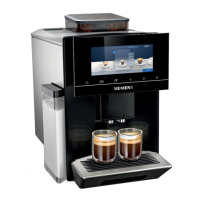
